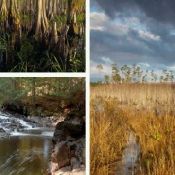Fixing Water By Fixing Land: What Works And What Doesn’t
All around the world, from Lima to Dar es Salaam, cities are looking to keep their water flowing by nurturing the watersheds that feed their rivers and streams. Now The Nature Conservancy and the Environmental Law Institute have taken stock of what works and what doesn’t. Here’s a look at their latest guidance on watershed restoration.

9 October 2014 |Taking a watershed approach means strategically identifying and directing wetland and stream restoration and protection projects to best meet the needs of the watershed.
The Environmental Protection Agency (EPA) labeled it the most effective framework to meet today’s water resource challenges. In 2008 the EPA and the Army Corp of Engineers (Corps) published the Final Compensatory Mitigation Rule, which required for the first time that the Corps use a watershed approach when making compensatory mitigation decisions.
Despite this general consensus, implementing a watershed approach remains challenging. “Using a watershed approach may mean a more significant up-front investment, but the conservation outcomes can be significant,” says Jessica Wilkinson, a Senior Policy Advisor on mitigation at the conservation organization The Nature Conservancy (TNC). “The watershed approach can direct both compensatory mitigation projects and voluntary, non-regulatory protection and restoration projects to the best sites leading to more significant, watershed-scale conservation outcomes.
A lot of money is spent every year on mitigation programs that deliver less than stellar results, Wilkinson says. According to a 2007 study from the Environmental Law Institute (ELI), nearly $4 billion is spent on land restoration and protection through mitigation annually. This money has obvious potential to contribute to conservation but perhaps lacks the guidance to do so effectively.
To help with this aspect of the problem, TNC and ELI recently published the Watershed Approach Handbook: Improving Outcomes and Increasing Benefits Associated with Wetland and Stream Restoration and Protection Projects. Through on-the-ground pilot projects sponsored by the two organizations, as well as EPA and the Corps, the handbook demonstrates how a watershed approach contributes to flood mitigation, better water quality and quantity and species habitat among other ecosystem services.
“We felt that through our respective expertise on policy and science, we could contribute to advancing a vision for the watershed approach that would help maximize the conservation outcomes of mitigation,” Wilkinson says. “So mitigation can contribute to larger landscape and watershed goals and get bigger better conservation bang for the buck.”
The intention of both organizations is to influence a shift in decision-making toward a landscape- or watershed-level and away from the project-by-project basis programs are currently operating under. It’s aimed at the parties involved in the planning process: mitigation bankers, state agencies, conservation organizations and members of the Interagency Review Teams that evaluate compensatory mitigation proposals.
Wilkinson notes the particular importance of the state-level actors. The managers of state wetland mitigation programs have been real innovators in this space, she says. ELI emphasized this point last year in another handbook that provides information on the range of tools being used at state and local levels countrywide. This new handbook, then, takes it one step further by providing guidance on how to apply these tools in a way that delivers high-value conservation.
“A watershed approach can maximize multiple benefits of mitigation and restoration,” Wilkinson says. “But in order for this to happen, state agencies and conservation organizations need to know about the opportunity and reach out to their partners at the Corps IRT agencies and provide them with information on the needs of watersheds and the most important places to which compensatory mitigation investments should be directed.”
Please see our Reprint Guidelines for details on republishing our articles.

